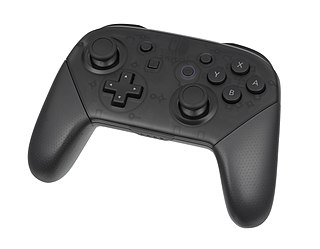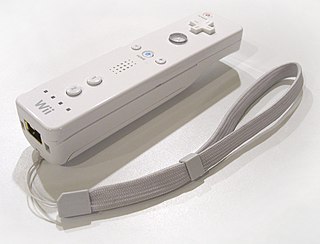
In video games and entertainment systems, a motion controller is a type of game controller that uses accelerometers or other sensors to track motion and provide input.

In video games and entertainment systems, a motion controller is a type of game controller that uses accelerometers or other sensors to track motion and provide input.
Early uses of motion controllers included the Sega AM2 arcade game Hang-On , which was controlled using a video game arcade cabinet resembling a motorbike, which the player moved with their body. This began the "Taikan" trend, the use of motion-controlled hydraulic arcade cabinets in many arcade games of the late 1980s, two decades before motion controls became popular on video game consoles. [1]
The Sega Activator was based on the Light Harp invented by Assaf Gurner. It was released as an optional accessory for the Mega Drive (Genesis) in 1993 and could read the player's physical movements using full-body motion sensing. It was a commercial failure due to its "unwieldiness and inaccuracy". [2]
The Sega VR headset was an early unreleased VR device with built-in motion sensing, first announced in 1991. Its sensors tracked the player's movement and head position. [3] Another early example is the 2000 light gun shooter arcade game Police 911 , which used motion sensing technology to detect the player's movements, which are reflected by the player character within the game. [4] The Atari Mindlink was an early proposed motion controller for the Atari 2600, which measured the movement of the user's eyebrows with a fitted headband.[ citation needed ]
Motion controllers became more widely distributed with the seventh generation of video game consoles. The Nintendo Wii console's Wii Remote controller used an image sensor [5] so it could be used as a pointing device along with an accelerometer to track straight-line motions and the direction of gravity. The Nunchuk accessory for use in a second hand also featured an accelerometer. A later line of accessories and refreshed controllers labeled with the Motion Plus feature added gyroscopic sensors to track three axes of rotation.
The PlayStation 3 launched with the Sixaxis controller included, which featured three-axis accelerometer motion sensing and a one axis gyroscope while not including the haptic feedback (vibration) seen in other modern consoles citing interference concerns. [6] Both features were included in the later DualShock 3 controller refresh.
Several wand-based devices with accelerometer and gyroscopic sensors followed, including the ASUS Eee Stick, Sony PlayStation Move (adding computer vision via the PlayStation Eye to aid in position tracking), and HP Swing. [7] Other systems used different mechanisms for input, such as Microsoft's Kinect, which combined infrared structured light and computer vision, and the Razer Hydra, which used a magnetic field to determine position and orientation.
Nintendo and Sony would adopt six degrees of freedom (6DOF) motion sensing using gyroscopes and accelerometers as a standard feature in successive generations starting with their handheld consoles the 3DS and the PS Vita, both of which had the required three-axis accelerometers and gyroscopes. In the eighth generation of video game consoles Nintendo and Sony included those sensors as a standard feature of their two handed game controllers, the Wii U GamePad and the DualShock 4. The consoles also had support for some devices in the previous generation of motion controllers depending on individual games.
Valve Corporation's Steam Controller was designed solely for use with PC's and required its Steam software. Its 6DOF sensors were made available for use by games published on Steam, and user options allowed the use of its gyroscope as a pointer control. Many of its features would go on to be included in the Steam Deck.
The Nintendo Switch hybrid home/portable console and its included Joy-Con controllers feature 6DOF sensors in each controller in the pair as well as in the main body of the console. The optional Nintendo Switch Pro Controller and Poké Ball Plus controllers also feature 6DOF sensors.
In the ninth generation the Sony PlayStation 5 continues to provide similar motion sensing for the included DualSense controllers, while supporting the use of older generations of motion controllers when playing backwards compatible games.

A video game console is an electronic device that outputs a video signal or image to display a video game that can be played with a game controller. These may be home consoles, which are generally placed in a permanent location connected to a television or other display devices and controlled with a separate game controller, or handheld consoles, which include their own display unit and controller functions built into the unit and which can be played anywhere. Hybrid consoles combine elements of both home and handheld consoles.

A game controller, gaming controller, or simply controller, is an input device or input/output device used with video games or entertainment systems to provide input to a video game. Input devices that have been classified as game controllers include keyboards, mice, gamepads, and joysticks, as well as special purpose devices, such as steering wheels for driving games and light guns for shooting games. Controllers designs have evolved to include directional pads, multiple buttons, analog sticks, joysticks, motion detection, touch screens and a plethora of other features.

The Wii is a home video game console developed and marketed by Nintendo. It was released on November 19, 2006, in North America and in December 2006 for most other regions of the world. It is Nintendo's fifth major home game console, following the GameCube and is a seventh-generation console alongside Microsoft's Xbox 360 and Sony's PlayStation 3.

A gamepad is a type of video game controller held in two hands, where the fingers are used to provide input. They are typically the main input device for video game consoles.
The DualShock is a line of gamepads developed by Sony Interactive Entertainment for the PlayStation family of video game consoles. It is named for vibration-feedback and analog controls. It was introduced in November 1997 as a secondary peripheral for the first PlayStation console. The console's bundle was updated to include DualShock, and phase out the original PlayStation controller and the Dual Analog Controller. The DualShock is the best-selling gamepad of all time by units sold, excluding bundled controllers.
The history of video game consoles, both home and handheld, began in the 1970s. The first console that played games on a television set was the 1972 Magnavox Odyssey, first conceived by Ralph H. Baer in 1966. Handheld consoles originated from electro-mechanical games that used mechanical controls and light-emitting diodes (LED) as visual indicators. Handheld electronic games had replaced the mechanical controls with electronic and digital components, and with the introduction of Liquid-crystal display (LCD) to create video-like screens with programmable pixels, systems like the Microvision and the Game & Watch became the first handheld video game consoles.

An analog stick, also known as control stick, joystick or thumbstick, is an input device for a controller that is used for two-dimensional input. An analog stick is a variation of a joystick, consisting of a protrusion from the controller; input is based on the position of this protrusion in relation to the default "center" position. While digital sticks rely on single electrical connections for movement, analog sticks use continuous electrical activity running through potentiometers to measure the exact position of the stick within its full range of motion. The analog stick has greatly overtaken the D-pad in both prominence and usage in console video games.
A video game accessory is a distinct piece of hardware that is required to use a video game console, or one that enriches the video game's play experience. Essentially, video game accessories are everything except the console itself, such as controllers, memory, power adapters (AC), and audio/visual cables. Most video game consoles come with the accessories required to play games out of the box : one A/V cable, one AC cable, and a controller. Memory is usually the most required accessory outside of these, as game data cannot be saved to compact discs. The companies that manufacture video game consoles also make these accessories for replacement purposes as well as improving the overall experience. There is an entire industry of companies that create accessories for consoles as well, called third-party companies. The prices are often lower than those made by the maker of the console (first-party). This is usually achieved by avoiding licensing or using cheaper materials. For the mobile systems like the PlayStation Portable and Game Boy iterations, there are many accessories to make them more usable in mobile environments, such as mobile chargers, lighting to improve visibility, and cases to both protect and help organize the collection of system peripherals to. Newer accessories include many home-made things like mod chips to bypass manufacturing protection or homemade software.

The Wii Remote, also known colloquially as the Wiimote, is the primary game controller for Nintendo's Wii home video game console. An essential capability of the Wii Remote is its motion sensing capability, which allows the user to interact with and manipulate items on screen via motion sensing, gesture recognition, and pointing which is used for the console, using accelerometer and optical sensor technology. It is expandable by adding attachments. The attachment bundled with the Wii console is the Nunchuk, which complements the Wii Remote by providing functions similar to those in gamepad controllers. Some other attachments include the Classic Controller, Wii Zapper, and the Wii Wheel, which has originally been used for the racing game, Mario Kart Wii.

The Sixaxis is a wireless gamepad produced by Sony for their PlayStation 3 video game console. It was introduced alongside the PlayStation 3 in 2006 and remained the console's official controller until 2008. The Sixaxis was succeeded by the DualShock 3, an updated version of the controller that, like the DualShock and DualShock 2 controllers, incorporates haptic technology – also known as force feedback. A Sixaxis controller can also be used with PSP Go and the PlayStation TV via Bluetooth after registering the controller on a PlayStation 3 console.
PlayStation is a video gaming brand that consists of five home video game consoles, two handhelds, a media center, and a smartphone, as well as an online service and multiple magazines. The brand is produced by Sony Interactive Entertainment, a division of Sony.

The Japanese multinational consumer electronics company Nintendo has developed seven home video game consoles and multiple portable consoles for use with external media, as well as dedicated consoles and other hardware for their consoles. As of September 30, 2021, in addition to Nintendo Switch, Nintendo has sold over 863.07 million hardware units.
Light-gun shooter, also called light-gun game or simply gun game, is a shooter video game genre in which the primary design element is to simulate a shooting gallery by having the player aiming and discharging a gun-shaped controller at a screen. Light-gun shooters revolve around the protagonist shooting virtual targets, either antagonists or inanimate objects, and generally feature action or horror themes and some may employ a humorous, parodic treatment of these conventions. These games typically feature "on-rails" movement, which gives the player control only over aiming; the protagonist's other movements are determined by the game. Games featuring this device are sometimes termed "rail shooters", though this term is also applied to games of other genres in which "on-rails" movement is a feature. Some, particularly later, games give the player greater control over movement and in still others the protagonist does not move at all. On home computer conversions of light-gun shooters, mouse has been often an optional or non-optional replacement for a light gun.

The Wii MotionPlus (Wiiモーションプラス) is an expansion device for the Wii Remote, the primary game controller for the Wii. The device allows more complex motion to be interpreted than the Wii Remote can do alone. Both the Wii and its successor, the Wii U, support the Wii MotionPlus accessory in games.

PlayStation Move is a motion game controller developed by Sony Interactive Entertainment. Initially released in 2010 for use with the PlayStation 3 home video game console, its compatibility was later expanded to its successor, the PlayStation 4 in 2013, its PlayStation VR platform in 2016 and the PlayStation 5 in 2020. Conceptually similar to Nintendo's Wii Remote and Microsoft's Kinect, its function is based around controller input in games stemming from the actual physical movement of the player. The Move uses inertial sensors in the wand to detect motion while the wand's position is tracked using a PlayStation Eye or PlayStation Camera. The device was generally well received by critics, but has not quite met Sony's goals for integration into the market.
Since the release of the Nintendo Wii, many aesthetic, ergonomic and functional accessories have been developed by third parties for the console’s controller, the Wii Remote.
Sensors able to detect three-dimensional motion have been commercially available for several decades and have been used in automobiles, aircraft and ships. However, initial size, power consumption and price had prevented their mass adoption in consumer electronics. While there are other kinds of motion detector technologies available commercially, there are four principle types of motion sensors which are important for motion processing in the consumer electronics market.

A virtual reality game or VR games is a video game played on virtual reality (VR) hardware. Most VR games are based on player immersion, typically through head-mounted display unit or headset with stereoscopic displays and one or more controllers.

In the video game industry, the market for home video game consoles has frequently been segmented into generations, grouping consoles that are considered to have shared in a competitive marketspace. Since the first home consoles in 1972, there have been nine defined home console generations.